This blog post on “The June 1944 Normandy Invasion and the Bane of Technologically Illiterate Officers in the Luftwaffe” marks the second in a series of posts departing from past history columns I’ve written for Chicagoboyz in that it is exploring a theme I refer to as “The Bane of Technologically Illiterate Military Leaders.”[1] .
The issue with ‘Technologically Illiterate Military Leaders‘ I’ll be exploring in this and future articles is that such leaders tend to make the same classes of mistakes over and over again. And when those military leaders reach flag rank on the bones of theories and doctrines that fail the test of combat through their technological illiteracy. They then bury the real reasons why those doctrines failed behind walls of jargon and classification to avoid accountability for those failures.
In this particular case, the mistake is how the otherwise technically competent Luftwaffe Funkaufklärungsdienst (Roughly translated — Electronic Intelligence Early Warning Service) managed to miss a completely unambiguous invasion warning for the Normandy Invasion — D-Day, June 6th 1944 — the night before the invasion.
This happened because the German officers over the Luftwaffe technicians were technologically illiterate regards both the Allied identification friend or foe (IFF) and Allied radio navigation systems they were monitoring, as well as the radar techniques their own Luftnachrichten Dienat (Air Surveillance Service) were using to track RAF Bomber Command night bomber streams through chaff.
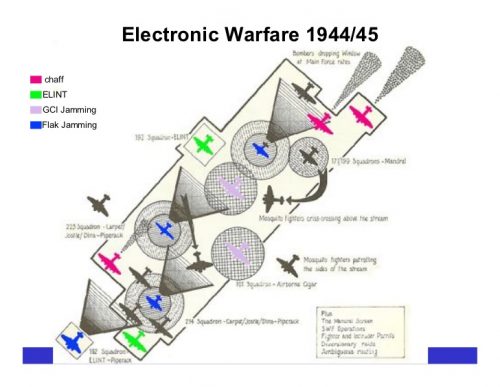
.
Electronic warfare is much like mine sweeping/hunting at sea, or combat engineers breaching a minefield on land, in that it is a thankless job when it is done right and “hard” on military officers careers in exercises/planning. Thus it tends to be avoided, even when it is central to recorded military history. Case in point — When Stephen L. McFarland wrote “Conquering the Night: Army Air Forces Night Fighters at War” in the late 1990’s (pub date 1998) as a part of “AIR FORCE HISTORY AND MUSEUMS PROGRAM.” He completely left out the fact that German bomber tail warning radars were picking up Allied night fighter IFF challenges. This was a fact that Alfred Price had published fourteen years earlier in 1984!
The Rise of the Luftwaffe Funkaufklärungsdienst
The falling behind of the Luftnachrichten Dienat (Air Surveillance Service) in the face of increasing British Royal Air Force (RAF) use of what is now called electronic warfare techniques lead to the separation of the German low level signals intelligence into the new passive electronic signal tracking organization. In particular it was the RAF use of dropped decoys — called variously “Window” or “ROPE” then and generally called “Chaff” now — to blind German radars combined with the use of H2S radar on RAF pathfinder bombers that lead to the creation of the Funkaufklärungsdienst for both the passive tracking of RAF night bomber streams and jamming of RAF radio navigation bombing aids. See the Steve Zaloga passage below:
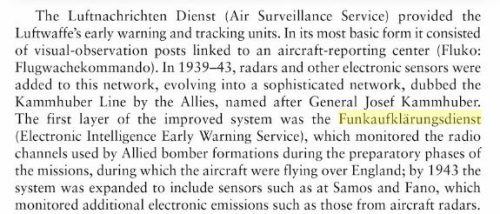
The Funkaufklärungsdienst adapted many German radar systems to a passive tracking functions and produced systems to jam the Allied GEE radio navigation system and long wave length OBOE radio beacon bombing systems. Col. Michaël SES Svejgaard at his web site on WW2 German night fighter defenses in Denmark described the Funkaufklärungsdienst as follows:
https://www.gyges.dk/Gebiets%20nachtjagd.htm
A special organization was established in order to, through passive receivers, detect, track and exploit emissions from the bombers: The Funkmess Aufklärungs Dienst. Stations from this organization were deployed through Germany and the occupied countries from the spring 1944 and onwards. Reports from these stations were passed to a Meldekopf/Gefechtsauswertung where it was processed and then passed to the GefStd of the JD and displayed on the Hauptlage Karte along with the radar plots. In Diogenes the nickname HUGO was used to describe the Funk.Auf.Kl. Cell.

Between the winter and summer of 1944 the Funkaufklärungsdienst had deployed a vast network of passive tracking stations across Western Europe.
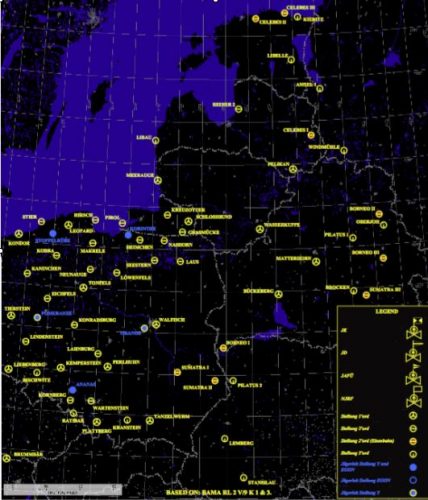
Growing a High Tech Military Service While Losing A War
The key issue for the Funkaufklärungsdienst in June 1944 was the same one facing Germany as a whole. It was the issue of trained manpower. There was not enough. The Funkaufklärungsdienst was stood up 2.5 years after the German Army started drafting all the electrical engineers and technicians it could to hand rifles too and send them to the bloody maw that was the Russian Front.
While there was a core of Luftwaffe radio-intercept units — which had existed prior to the creation of the Funkaufklärungsdienst — that were untouched by the Eastern Front’s demand for bodies. The other electronic warfare listening and jamming units of the Funkaufklärungsdienst were given decidedly 2nd and 3rd rate technical personnel to operate their various sensors. It was worse at higher leadership levels in the Funkaufklärungsdienst as those needing the proper flexibility of mind to anticipate the measure, counter-measure, counter-counter-measure give and take of electronic warfare with a “peer opponent” were less than “one deep” in the command structure. The Funkaufklärungsdienst never got the German manpower priorities to get it’s share of first rate talent, nor the resources too train up the manpower it did get to competitive levels of skill in dealing with the Western Allies.
The Evolving of OBOE and the Funkaufklärungsdienst
No where is the Funkaufklärungsdienst’s lack of flexibility and vision in it’s top leadership seen better than its battle to jam the RAF’s OBOE radio beacon bombing system. This is how the Wikipedia article on OBOE puts it:
.
Oboe missions were clearly identifiable to German radar operators; the aircraft would start some distance north or south of the target and then approach it on an arcing path they referred to as “Boomerang”. Although the operators quickly became accustomed to these aircraft, actually arranging an interception of the high-flying and high-speed aircraft proved extremely difficult.
.
It took the Germans more than a year to decipher the operation of the system, led by the engineer H. Widdra, who had detected the British “Pip-squeak” Identification friend or foe [IFF] system in 1940. The first attempt to jam Oboe took place at the end of August 1943 during an attack on the Bochumer Verein steelworks in Essen. A system set up at the Maibaum tracking station in Kettwig broadcast false dot and dash signals on the 1.5 m band, hoping to make it impossible for the pilot to figure out if they were at the right position. This was the same technique that the British had used against German systems during The Blitz.
.
However, the Oboe system had already moved to the microwave-frequency 10 cm Oboe Mk. II, but the British kept broadcasting the older signals as a ruse.

The Wikipedia article is actually understating the matter. Peter Jacobs’ “Night Duel Over Germany: Bomber Command’s Battle Over the Reich During WWII” describes the evolution of OBOE in the period after August 1943 as follows:
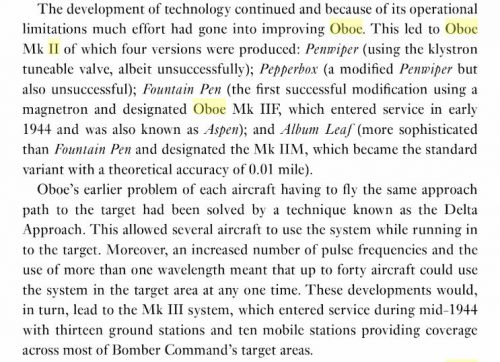
Once the German warning service saw and monitored one bombing radio navigation system working. It had stopped looking for more “like purpose signals” at other frequencies.
Rule #1 of a Spectrum Fight — Never, NEVER, *NEVER* stop looking for new enemy signals on every frequency just because you find one and you think you know what it is doing. This mistake is one of the key tells of a technologically illiterate military leadership in running an electronic warfare campaign.
The reality was the RAF had not only deployed a new version of OBOE that the Funkaufklärungsdienst had missed monitoring. It had deployed _FIVE_. The RAF working with the British Branch of the MIT Radiation Laboratory had deployed and replaced four versions of the undetected 10cm band Mark II OBOE system. Then the RAF introduced OBOE Mark III in time for the Normandy invasion. A version that didn’t have the easily identifiable “Boomerang” flight paths that Luftnachrichten Dienat radar operators keyed upon to direct night-fighters. This would have very personally dire consequences for the Funkaufklärungsdienst which would lead directly to it’s missing an unmistakable invasion warning.
Normandy and the Coming of OBOE ARC LIGHTS
There was a significant and wide ranging anti-transportation air campaign to isolate the Normandy battlefield prior to June 6th 1944. Less well know are the operations of the RAF Bomber Command to isolate Normandy via destroying German military command, control, communications and intelligence (C3I) sites in North West France. In particular, there were six facilities struck with maximum short range bomb load OBOE strikes of 70 to 120(+) Lancaster bombers each with 450 to 600 tons of bomb per target. The Lancaster’s averaged 5.75 tons per plane in these raids. In other words, these were OBOE ARC LIGHTS**.
[**ARC LIGHT refers to the 1965 to 1973 era use of three plane B-52 formations to drop bombs bombs in the Republic of South Vietnam in support of ground troops. Typical bomb loads were 20 to 27 tons of bombs per B-52.]
Two C3I targets were Luftwaffe “Bernhard/Bernhardine”night-fighter radio navigation beacons. One was destroyed and one inoperative on D-Day after RAF Bomber Command Attacks.
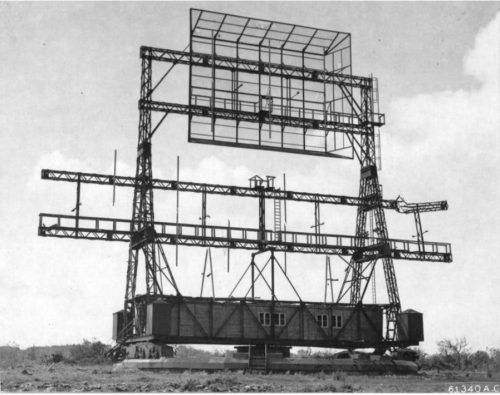
The FuSAn 724/725 “Bernhard” transmitted in the 30 – 33.3 Mhz VHF radio band below today’s VHF television channel 2. It was was high powered, directional and it’s antenna rotated twice a minute. Night fighter radar/radio operators could switch between 2 stations and obtain a fix every minute and did not have to work two radios to find a jamming free frequency. This set of characteristics very made them extremely difficult to jam as a number of airborne jammers had to orbit the antenna between it and any German night fighters in its up to 400km range. There simply were not enough Allied jammer planes for this role on D-Day, hence the RAF attacks.
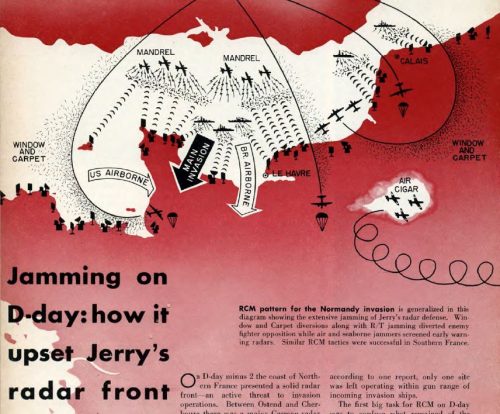
Three more C3I targets were strategic radio nodes were struck at Boulogno/Mt. Couple, Beaumont Hague/Au Feure , and Dieppe/Bernaval le Grand. All three were destroyed with Boulogno/Mt. Couple requiring a second OBOE strike to accomplish the objective.
The final RAF Bomber Command strike was where the pigeons of the Funkaufklärungsdienst’s technologically incompetent leaders came home to roost. The last target was the Funkaufklärungsdienst’s Cherbourg/Urville-Hague headquarters in North Western France. This is how the 12 May 1945 RAF report “REPORT ON AIR OPERATIONS PRIOR TO AND IN SUPPORT OF OPERATION “NEPTUNE” described the attack:
Cherbourg/Urville-Hague. This station is now known to have been the headquarters of the Nazi “Y” Service in North Western France. The attack on this important W/T centre was made on 3rd/ 4th June by 99 aircraft, dropping 570 tons of bombs. The results were remarkable, the centre of a very neat bomb pattern coinciding almost exactly with the centre of the target area. The photographic interpretation report may be quoted verbatim :-
.
“(a) The station consisted of a line of W/T masts running diagonally across an old fort, and the Headquarters buildings, 150 yards to the south.
.
(b) Both the masts and the buildings have been demolished; all have received many direct hits. The outline of the only two large blast-wall protected buildings is only just discernible among the craters and the debris.
.
(c) The target is at the centre of a well-defined concentration of many hundreds of craters. ” The station is completely useless. The site itself is rendered unsuitable for rebuilding the installation, without much effort being expended in levelling and filling-in the craters.”
.
126. The success of this attack on the German Air Force “Y” Headquarters must have been a major catastrophe for German Intelligence and it may well be that it was an important contributory factor to the lack of enemy air reaction to the assault.
The text in paragraph 126 above was the RAF bragging without giving away the “ULTRA Secret,” because the RAF was very much aware that it had done just that — inflict a catastrophic intelligence disaster — upon the Luftwaffe. The RAF Bomber Command had killed the 1st string senior Funkaufklärungsdienst leadership in France, leaving the technically incompetent bureaucratic hacks in a cobbled together alternate headquarters for the night shift during the Normandy invasion.
How the Funkaufklärungsdienst Blew the Normandy Invasion Call
One of the key things about the Western allies D-Day invasion of Normandy is how many aircraft were involved. There were upwards of 7,000 aircraft sorties flying over the Normandy area the day of the invasion and close to 10,000 sorties when the wider RAF operations over France, the English Channel, North Sea and Bay of Biscayne by RAF Coastal Command, RAF Bomber Command, RAF Fighter Command and Allied Expeditionary Air Forces (AEAF) are taken into account.
Words cannot do justice to the numbers and scale of this air effort, so see the following four maps:

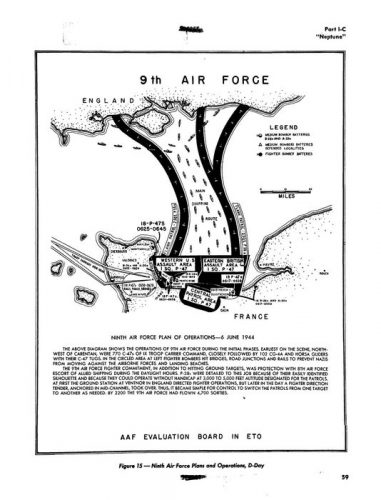
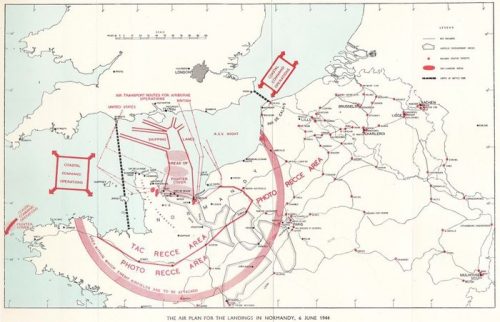
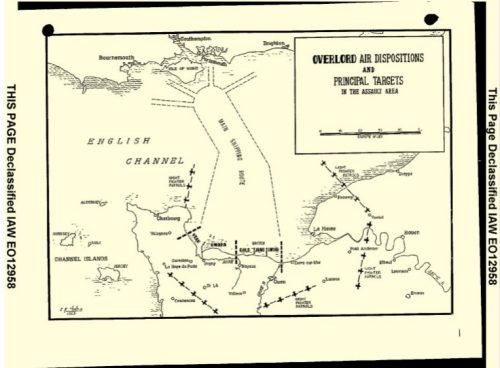
Each and every one of those planes in the four maps above had to have it’s Mk III identification friend or foe (IFF) system tested in the 12 hours before invasion air operations kicked off. That alone would have set off an incredible electronic racket. This was compounded by design limitation in the IFF system called “Squitter” and a phenomena identified in modern electronic warfare as “Unintended Emissions,” or “UE” These two issues combined together literally blanked radars across the UK and blew the D-Day deception plan to electronic intercept operators in the Funkaufklärungsdienst.
IFF Squitter was technically described by the US Navy as follows:
COMINCH P-08
RADAR BULLETIN No. 1 A
(RADONE A)
THE CAPABILITIES AND LIMITATIONS OF SHIPBORNE RADAR
CHAPTER IX
Radar Recognition Systems–IFF
4. Matériel.
.“…On the other hand, too great sensitivity is also harmful because the set may be triggered by ignition noises or other sparking, or the set may be triggered by itself, should certain components fail. Self-triggering or responding to noise, which has been termed “squitter”, is objectionable because under this condition many unwanted pulses are radiated without any challenge being received. Thus, squitter causes excessive interference with the whole IFF band, and it may prevent recognition of any of the contacts detected by radar, as well as providing a continuous signal for the enemy’s direction finders.
Much of the “squitter” described above was actually the result of the phenomena of “U.E.” There were a lot of allied radio and radar signals in/near the MkIII IFF’s 157-187 Mhz, plus 212 Mhz, frequency range. Any signal in those bands caused an IFF to radiate a response.
In the hours before D-Day there were lots of turning propellers in close proximity. These propellers would amplitude modulate and frequency modulate any in-band signal. That was a far more likely radio signal source for IFF “squinter” than the US Navy’s explanation of ignition noise. Which was both wideband and low power.
Since engine rotations per minute (RPM) and blade count determine the chopping frequency radio signals reflected off of propellers. As the engines gathered RPM, the pulse repetition frequency (PRF) of the modulation would slowly increase, sweeping across the PRF of the Mk.III IFF system. And UK airfields immediately before D-Day were densely packed with planes turning propellers with active IFF.
Short form — This was an undeniable signal that the Allies were about to invade Western Europe. It was reported as such by Funkaufklärungsdienst intercept operators. And it was not believed by Funkaufklärungsdienst leadership.
The following is from ROYAL AIR FORCE HISTORICAL SOCIETY JOURNAL 28, Copyright 2003: Royal Air Force Historical Society, First published in the UK in 2003 by the Royal Air Force Historical Society ISSN 1361-4231
MORNING DISCUSSION PERIOD
.
Page 52
.
Peter Hearne. I was struck by a comparison between a point raised in
Mr Streetly’s paper and a chapter in R V Jones’ book, Most Secret War, regarding the vulnerability of Bomber Command’s aircraft to German night fighters homing on their transmissions. This would possibly have involved IFF and the problem was certainly present in the context of H2S and MONICA. Jones recalls that he had a conversation with a German scientist who said that they were very surprised at how lax Bomber Command’s discipline was, or perhaps how unguarded they were; either way, it seems that the Germans were certainly planning to exploit this weakness..
I wondered whether there was any sort of read-across between our own night fighter’s use of SERRATE and PERFECTOS and our related efforts to protect Bomber Command’s aircraft. In that connection someone has written, (it may have been Dr Price) that the one person who correctly predicted that D-Day was about to happen, was a German radio operator on the listening watch in Holland who detected an enormous amount of tuning pulses from RAF aircraft on the night of 5 June and deduced that the invasion might take place on the following day. Happily, his message was disregarded.
And here is where we see the technologically illiterate Luftwaffe leadership in action. The Luftwaffe air defenses exploited the prop modulation of Allied Bomber stream returns in their Wurzburg radars for non-cooperative target recognition (NCTR). The radar operators of the Luftnachrichten Dienat would have understood what “squitter” of the scale heard the night of 5-6 June 1944 meant, if they were in the loop, but they were not.
However, issues of security clearance “Need to Know” means you generally have experts on enemy electronic systems, and your own electronic systems. There are vanishingly few who know both systems for technical and security clearance reasons. And electronic warfare commanders tend to keep such people close to them.
Which bring’s up rule #2 of a ‘Spectrum Fight” and it’s corollary.
Spectrum Fight Rule #2, always have a complete back up and silent command headquarters with competent command staff to take over if the first is destroyed. You need to have some part of the headquarters command staff analyzing past operations and planning future ones. Put these people in the alternate and electronically silent command headquarters with a secure land line to the current operations headquarters.
Spectrum Fight Rule #2 Corollary, irreplaceable talent — for technical training or security clearance reasons — must always be kept at the back up silent command site. Or better yet, on a secure land line apart from either facility for military commander to consult with.
The Funkaufklärungsdienst leadership on the night of 5/6 June 1944 failed both rules and became another classic example of the Bane of Technologically Illiterate Military Leaders.
-End-
Great post!
This is a comment I got on my post from an e-mail list of mine:
>>Generals are jocks.
>>
>>Intel (all) are nerds.
>>
>>Jocks are incapable of listening to nerds.
If you squint at what I wrote above just right, you can see exactly that.
Joe Rochefort might agree.
Rochefort received no official recognition during his lifetime because he was made a scapegoat for the embarrassment of OP-20-G. Redman (whose brother was the influential Rear Admiral Joseph Redman) complained about the operation of the Hawaii station; as a result, Rochefort was reassigned from cryptanalysis to command the floating dry dock ABSD-2 at San Francisco.
That Was his reward for MidWay. Command of a floating dry dock.
I did a post on this for my blog a while back.
https://theartsmechanical.wordpress.com/2017/03/16/losing-the-war-day-by-day/
A lot of it was that I was a bit amazed at the lack of German microwave level radio research and development. The US and Britain did a lot more of that than the Germans or the Japanese did and the payoffs were incredible. For a long time, I thought it was because neither the Germans nor the Japanese had looked at cavity magnetrons. but they both had. I suspect that the nerd war wasn’t sexy to the Jock types that ran the Japanese and German militaries and the electronic war evolved so fast that the Germans never really understood what was hitting them.
Jccarlton,
>>For a long time, I thought it was because neither the Germans nor the Japanese had looked at cavity magnetrons. but they both had.
Japanese radar has been underestimated and talked down in American military histories for 75 years, Particularly by the US Navy who was heavily victimized by Japanese airborne radar during the Kamikaze campaign.
The Japanese had a different technological tool kit to work from and made a number of poor choices due to factional issues between the Army and Navy, but in many cases they were no worst than some of the issues between the US Army and US Navy. They simply hurt the Japanese more because they were working from a far smaller material/industrial base
Point in fact, the Japanese did indeed have a magnetron based radar. And they invented theirs only a few months after the British.
See:
The Pacific War Online Encyclopedia: Radar
pwencycl.kgbudge.com/R/a/Radar.htm
Japanese Radar Equipment in WWII
http://www.combinedfleet.com/radar.htm
This is the description of the Type 22 IJN surface search radar from combined fleet web site —
Type 22
Became Operational: September 1944, see notes below
War Status: wide operational use in war
Installed: surface ships, submarines
Purpose: anti-air, surface dectection and gunnery control
Wavelength: 10 cm
Peak Output: 2 kw
Transmitter: magnetron
Receiver: crystal
Detector: n/a
Detected: aircraft, group at 35 km, single at 17 km, surface ship (large) 34.5 km
Weight: surface ships 1320 kg, submarines 2140 kg
Number Built: 300
Antennae: horn type, send and receive separate use
Type 22 fitted to Kazegumo and Makigumo in March 1942, Hamakaze in June 1942, Akigumo and Yugumo in July 1942, Kongo, Haruna and Hyuga in October 1942, Katori, Kashima and Kashii in June 43,Yamato and Musashi in October 1943, other destroyers prior to September 1944. In wide use by mid-to late 1944. Type 22 radard while not designed for gunnery control provided moderately accurate data for this purpose.
Jccarlton,
>>For a long time, I thought it was because neither the Germans nor the Japanese had looked at cavity magnetrons. but they both had.
Regards this and the Germans…German radar scientists & engineers prized steady signal from klystrons far more than the shear power from magnetrons.
This concentration on steady frequency was an extension from a strategic German decision in the 1930’s that they were not going to use quartz crystals to control their VHF radios for reasons of a lack of access to such crystals in wartime.
A magnetron radar’s frequency wandered a lot from it’s setting and had to be recalibrated regularly for best performance. This had a lot of implications in terms of how you operate klystron versus magnetron radar.
Short form: Magnetron radar required far more highly trained and skilled radar operators than klystron radar.
German manpower resource limitations were such that their klystron based radar’s were heavily engineered such that they could be operated by less skilled and more available average intelligence people.
This left the German’s much more vulnerable to electronic warfare because their radar crew didn’t -know- their radar kit they way the Allies radar crews did.
However, the Allied never realized — until they overran France and could see a lot of different German radars — that the Germans took the same basic electronics and simply changed antenna’s and added power to get more performance.
Plus, the Allies never got around to using electronic scanning with their radar antenna’s the way the Germans did because 10 CM and 3 CM radar didn’t need big antenna’s.
The fact that “the enemy” has a different tool set and a _really_different_ mind_set_ on how to apply their tools was never really captured in the post-war histories.
It certainly wasn’t during WW2.
Every time we’ve had a microwave oven stop working, I have attempted repairs. Each time I have been surprised at the trivial nature of the part failure which stopped the oven, for example, a cracked plastic lever arm on a door closed detector switch. And surprised at the not mere difficulty but near impossibility of obtaining a replacement part, even with internet search tools enabling one to reach far beyond local appliance parts stores. I have succeeded only once at a repair. The experiences demonstrated why microwave ovens tend to get discarded and replaced rather than repaired. A technician’s charge (time and service call) for repair and realization of the finite life of the repair would make replacement the better choice. I have continued the attempts not because of cost-effectiveness, but because of curiosity…and, O.K., stubbornness.
The experiences also have let me examine a variety of magnetrons. Each time I did, I pondered how WWII nations and espionage efforts would have killed for what I looked at.
In case anyone else needs a primer on magnetron vs klystron, here is one.
Jccarlton.
Regards this —
>>I suspect that the nerd war wasn’t sexy to the Jock types that ran the Japanese and German militaries and the electronic war evolved so fast that the Germans never really understood what was hitting them.
Exhibit A from 1945 that the Japanese were no slouches in the “Nerd Wars”.
————
http://www.researcheratlarge.com/Ships/CV19/1945MarchAprilActionReportExceprt.html
RCM
(1) ENEMY RCM: During this operation it became increasingly evident that Japanese night flying aircraft have some means of knowing when our VF(N) are attempting to intercept them, possibly due to our use of IFF. Violent evasive maneuvers, changes in altitude and heading and dropping of quantities of what appeared to be 200 mc window resulted and the problems of the night intercept officer were increased.
At ranges of 60 and 70 miles the window seemed particularly effective since the SK/SC had difficulty in distinguishing between the bogey being intercepted and the window, especially when the bogey was being tracked at maximum range. Another night when a Betty was splashed about 20 miles East of the group of ESSEX VF(N) controlled by the HANCOCK, a second “Bogey” appeared immediately after the disappearance of the first and in proximity to the place where it was shot down. This same phenomenon was noted on another occasion off Formosa in early October when a single Emily was shot down by INDEPENDENCE VF(N) and second “Bogey” appeared almost in the space recently vacated by the Emily. In both cases it is suggested that the window only became visible to the radar after being dispersed for a few seconds after the sewing plane was splashed, or also the force of the explosion spread the window which was still contained in the plane.
On one occasion off Okinawa a single bogey flew a roughly circular course about the force as a center at a radius of about 60-70 miles. He was tracked for approximately 175 mi., and this radius may indicate the effective range of the radar in use since a strong radar signal was received at this time. This is in notable comparison to past performances where enemy aircraft have flown within 4-5 miles of a picket and 25-30 miles of the force apparently without detecting the presence of the disposition. This was noted off both Luzon and the Empire
———
FYI, the Japanese were the first to use “Window” in World War 2 at Guadalcanal several months ahead of the British at Hamburg.
I disagree, Trent. This was part of the learning curve on electronic warfare. You slam the Luftwaffe for not knowing all the lessons of 70 years of hindsight right at the beginning of the learning curve. AND you slam them for not having sufficient human resources.
What I see here is that the Luftwaffe air defense system in France was decapitated TWO DAYS before D-Day. That right there means the Funkaufklärungsdienst operators who spotted the invasion in advance would have been ignored anyway. Their highest HQ was gone on no notice. Its backup was undermanned and under-equipped because the Luftwaffe plain lacked the resources, not because of avoidable oversight. The backup HQ was too busy trying to regain control of its primary mission to deal with secondary matters.
Confederate General George Pickett was asked, after the Civil War, why the South lost at Gettysburg. He replied, “I always thought the Yankees had something to do with it.”
Very interesting read, Trent. After action reports show how very much thought went into determining from experience what worked. In addition to aiding visualizing the terror of the combat, one could also identify with the effort to determine frailty in the mechanisms providing defense.
That read, tho long, also provides insight into present efforts. For a specific, today-current example:
https://www.forbes.com/sites/lorenthompson/2019/03/11/raytheons-case-for-building-army-radar-grounded-in-deep-knowledge-of-gan-technology/#74a5847668ef
Tom,
The Luftwaffe had their night bombing radio beam systems jammed out of existence in the winter of Winter 1940-1941.
The Luftwaffe detected the RAF Fighter Command’s “pipsqueak” IFF that same winter.
The Channel Dash or Unternehmen Zerberus (Operation Cerberus) — where the Kriegsmarine (German navy) squadron of both of the Scharnhorst-class battleships, the heavy cruiser Prinz Eugen and escorts, ran a British blockade from Brest in Brittany with German jamming support — happened 11 February 1942.
The Luftwaffe jamming of Malta’s radars was in July of 1942.
The Battle of Hamburg, code named Operation Gomorrah, was 24 July 1943. This is when the RAF hit the Luftwaffe with “Window”.
Other RAF active jamming techniques supporting RAF Bomber Command were in use up to two year prior to Operation Gomorrah.
The British from 1940 and MacArthur’s Section 22 when it was kicked off in the summer of 1943 never stopped looking for new Axis radar and radio signals up and down the radio spectrum.
The Luftwaffe never looked for new enemy frequencies until other events made them look.
This was why 10 cm OBOE wasn’t looked for until July 1944.
The Germans by June 1944 had three(+) years of combat experience with “Spectrum Warfare” and the Funkaufklärungsdienst leadership blew both OBOE spectrum/capabilities and the Normandy “IFF squitter” invasion the call it should have made.